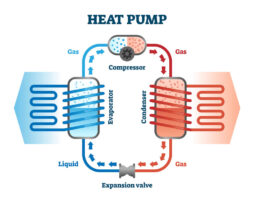REFRIGERATION AND HEAT PUMP SYSTEMS IN THERMODYNAMICS-II
Refrigeration and Heat Pump Systems in Thermodynamics-II
Refrigeration and Heat Pump Systems are fundamental components of modern life, playing a pivotal role in various industries and everyday applications. In the field of thermodynamics, these systems are a subject of great significance. This article delves into the essential aspects of Refrigeration and Heat Pump Systems, exploring their operation, components, and key principles.
Understanding the Basics
1. Thermodynamic Cycles
Refrigeration and Heat Pump Systems operate on thermodynamic cycles. These cycles consist of a series of processes that transfer heat and work to achieve the desired outcomes, whether it’s cooling a space or heating it. Common cycles include the Vapor Compression Cycle, Vapor Absorption Cycle, and Reverse Rankine Cycle.
2. Working Fluids
The choice of working fluid is crucial in these systems. Refrigerants like R134a and R410a are commonly used in refrigeration systems, while water-ammonia mixtures are prevalent in absorption refrigeration. The working fluid undergoes phase changes and transfers heat during the cycle.
Refrigeration Systems
3. Key Components
Refrigeration systems consist of key components, including a compressor, condenser, evaporator, and an expansion valve. Each component plays a distinct role in the cycle, with the compressor increasing the pressure of the working fluid, the condenser releasing heat, and the evaporator absorbing heat from the surroundings.
4. Coefficient of Performance (COP)
The COP is a vital performance metric for refrigeration systems, indicating their energy efficiency. It is defined as the ratio of heat transferred from the refrigerated space to the work input. A higher COP signifies greater efficiency.
Heat Pump Systems
5. Heat Pump Operation
Heat pumps are versatile systems that can provide both heating and cooling. They operate on the same principles as refrigeration systems but can reverse the direction of heat transfer. In the heating mode, they absorb heat from the outdoor air or the ground and release it inside, making them energy-efficient solutions for maintaining indoor comfort.
6. Applications
Heat pumps find applications in various sectors, including residential heating and cooling, commercial buildings, and industrial processes. They are an environmentally friendly alternative to conventional heating methods, as they can be powered by electricity and utilize renewable energy sources.
Efficiency and Sustainability
7. Environmental Impact
Refrigeration and Heat Pump Systems have a significant impact on the environment. The choice of refrigerants is crucial, as some can contribute to ozone depletion and global warming. Research and development in this area focus on finding environmentally friendly alternatives with lower Global Warming Potential (GWP).
8. Energy Efficiency Regulations
To promote energy efficiency and reduce greenhouse gas emissions, many countries have established regulations and standards for these systems. Compliance with these standards is essential to minimize the environmental footprint and reduce energy consumption.
Conclusion
Refrigeration and Heat Pump Systems are vital components of thermodynamics, and they play a crucial role in our daily lives. Understanding the principles and components of these systems is essential for efficient operation and sustainability. As technology advances and environmental concerns grow, these systems continue to evolve, offering more energy-efficient and eco-friendly solutions for cooling and heating needs.


